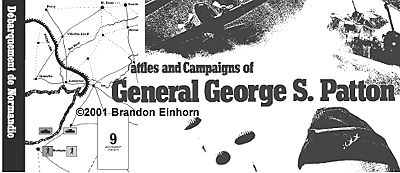
Published by House of Games/Waddingtons 1973
Designed by Sid Sackson
Components
24 movement cards (3*1; 2*2; 2*3; 2*4; 3*5; 2*6; 2*7; 2*8; 2*9; 3*10, 1*end of deck)
10 six-sided dice
16 Allied armor counters
16 German armor counters
40 allied infantry counters
40 german infantry counters
2 double sided maps 14"x22"
1 rulebook
1 flat box
Patton is a simple generic wargame from the old days, designed by one of Americaís most prolific game designers. Sid Sackson has designed many family/ business games including Acquire, Bazaar and Metropolis.
Patton has three scenarios: The Invasion of Sicily, the Normandy Breakout, and the Battle of the Bulge. The mounted area movement maps are 14Ēx22Ē, except for Sicily which is double sized at 27Ēx22Ē. There are 16 armored and 40 infantry units per side, probably representing divisions, colored blue or red. The graphics are unattractive (orange and green maps) but functional, as one would expect from games of this era. The rules are very simple and the playing time is fast, no more than an hour and probably less. There is no scale given, but scenarios last around 12 turns, so a turn probably represents a day or so.
The game requires skill and there are some elements of military strategy involved, but not many. This isnít really a wargame, itís a board game with a military theme, sort of like Stratego. It might be popular if it were reissued by Hasbro, with up to date graphics and plastic figures (similar to Battle Cry), and with a little more chrome, e.g., air strikes. Each player has a deck of 12 movement cards (with a value from 1-10) and alternate drawing one at the start of their respective turns. The sum of the value of the two cards (one German, one Allied) is the movement capability for the side for that turn. It costs one movement point to move a unit one space along a major road, two movement points to move along a secondary road, and three movement points to move along a trail.
In addition a maximum of five units may use any particular road per turn. This allows the defender (typically the Germans) to defend in a space accessible only from secondary and tertiary roads because of the difficulty the attacker has bringing units to bear. It typically takes a couple of turns to amass units adjacent to the target space. A fog of war rule would have been nice, at the least inverting the units and adding a few dummies. In addition, even if the attacker takes the position, he may be vulnerable to a counterattack by adjacent infantry or armor. Stacking is 10 units, and there are typically about 35 units per side.
Combat consists of the simultaneous exchange of fire and the removal of losses. Players roll a die for each armored unit or every two infantry units. A double inflicts a hit, a triple two hits, etc. Itís important to have infantry to absorb losses. The side that rolled higher (sum of the dice) wins and forces the other side to retreat. Typically victory is based on geographic control of towns. There is no provision for an overrun, so a single infantry division can hold up a stack of five armored divisions for a turn.
In the Normandy Breakout scenario the Allies have a large force advantage but itís difficult to bring their forces to bear unless the German is foolish enough to set up adjacent to the start line. Itís very much a game of attacking selected areas with a large force advantage so as to kill enemy armored unit.
Back to Simulacrum Vol. 3 No. 3 Table of Contents
Back to Simulacrum List of Issues
Back to MagWeb Master Magazine List
© Copyright 2001 by Steambubble Graphics
This article appears in MagWeb (Magazine Web) on the Internet World Wide Web. Other military history articles and gaming articles are available at http://www.magweb.com